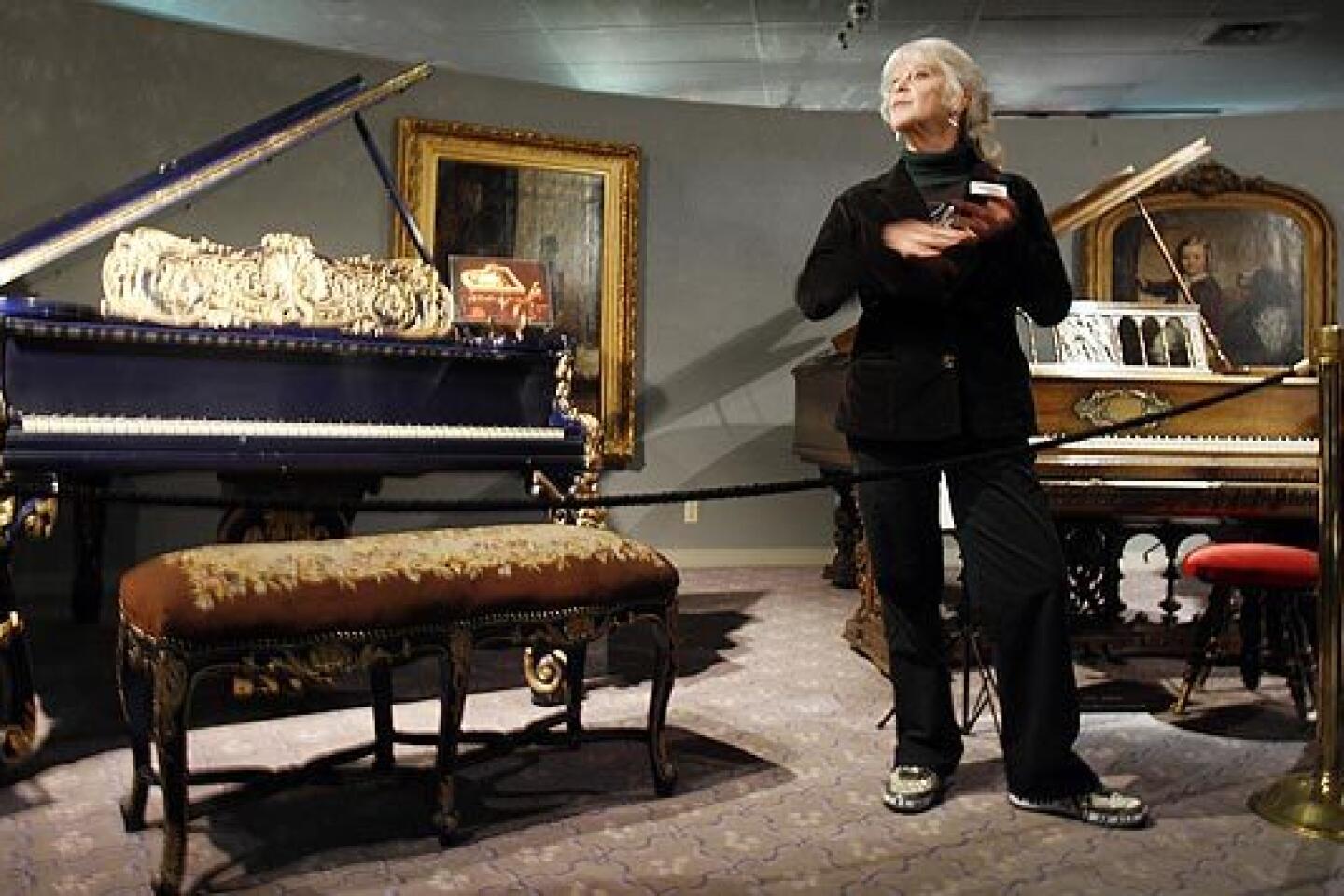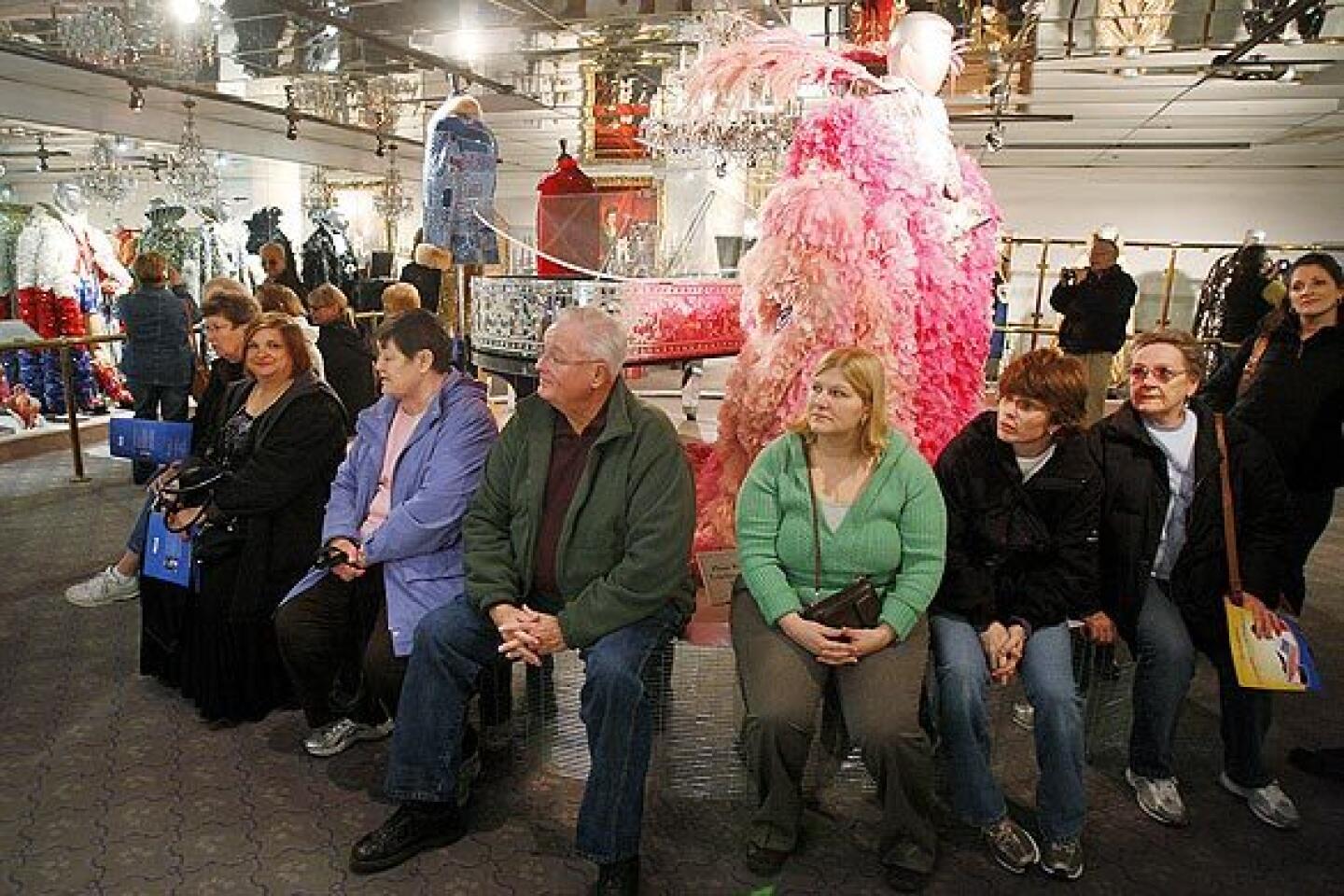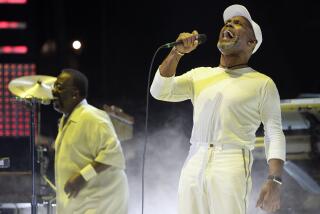Liberace gets re-glitzed
- Share via
LAS VEGAS — Liberace -- he of pink-feathered cape and “Beer Barrel Polka” fame -- hasn’t attracted too many fans among a generation weaned on pop-music tarts and gangster-rap thugs.
His legacy’s caretakers can’t stomach the idea of the pianist becoming a footnote. (He died in 1987.) But if his devotees have learned anything from a man who branded himself Mr. Showmanship, it’s how to fine-tune an image.
They haven’t focused on his music, which he took very seriously, but on his legendary flamboyance: They’ve retooled him as the originator of ostentation and trademarked him as the King -- and Queen -- of Bling.
For the Liberace Foundation’s sake, he needs to wow a new audience.
In recent years, the number of visitors to the Liberace Museum off the Strip has dropped by half, to about 50,000 annually. Surveys say many of them are Midwesterners old enough to remember hearing Liberace perform -- as a young man.
“His audience is slowly dying off,” says Darin Hollingsworth, executive director of the nonprofit foundation that oversees the museum and has awarded millions of dollars in college arts scholarships.
So, look for Liberace in new places. His sequined self is plastered on postcards, bumper stickers, T-shirts, tote bags, wallets and a book of paper cutouts called “Liberace: Your Personal Fashion Consultant” that has sold 10,000 copies. Online, fans can buy Liberace rings, Christmas ornaments, teddy bears, shot glasses, thimbles and even a $1,600 Swarovski crystal miniature grand piano.
Though some have grumbled that the glitter is outshining Liberace’s musical legacy, museum officials hope it will help folks fall for his life story. A once-impoverished Wisconsin virtuoso, Liberace sold out concert halls, won two Emmys and set up a charity long before it was a common celebrity accessory.
Few other household names have attempted a pop culture resurrection so long after their demise, says USC marketing professor C.W. Park. But hip-hop’s high rollers, he says, seem a good match for Liberace, who a reporter once dubbed His Lord High Excellency of Glitz.
“It’s like pouring gasoline on fire. It could really take off,” Park says.
To that end, the foundation recently rolled out $99 sneakers named Liberace Kicks -- the latest of 50 or so Liberace products sold in the U.S., London and Australia. With the sparkly piano-key-trimmed shoes from urban footwear company Kashi Kicks, “Liberace’s street credibility is absolutely bumped up,” a news release says.
It’s OK to chuckle, especially if you pull out your credit card at the same time: The foundation gets a percentage of the profits. A few years ago, Karan Feder, a former costume designer who moved to Vegas from Calabasas, visited the museum. She planned to gawk at Liberace’s get-ups, including a mink cape with 40,000 crystals and the 200-pound “King Neptune” outfit. But trolling through the gift shop, she noticed the museum had barely capitalized on Liberace’s camp.
“He was a very dead celebrity,” Feder says.
She and her husband, Michael, who run licensing company Fame Farm, noticed how other icons had been successfully reborn as pitchmen. Albert Einstein, Andy Warhol and Elvis Presley are among those who racked up millions of dollars in product and licensing fees last year.
Since Liberace was the man who suggested Elvis glitz up his stage garb, it was only appropriate that Mr. Showmanship sell his own trinkets -- with an arched eyebrow.
Consider, the Feders say, Liberace’s appetite for finer things: 400 costumes, more than half a dozen homes, 30 to 50 cars, at least 26 dogs, and a museum devoted entirely to himself. That’s not too far from MCs who guzzle Cristal champagne, adorn their teeth with diamonds and shower clubgoers with dollar bills.
“They’re the Liberaces of today,” Feder says.
In fact, Liberace gets a shout-out in “Bling: The Hip-Hop Jewelry Book” as a pioneer of the luxe life -- along with the movie “Scarface” and TV shows popular during hip-hop’s infancy, “Dynasty,” “Dallas” and “Lifestyles of the Rich and Famous.”
“He was very flamboyant and had no hesitation in showing his wealth,” says “Bling” coauthor Reggie Osse, a former music industry attorney. “The guy was just glowing with jewelry.”
Indeed, his bubble-gum-colored “Volks Royce” and mirror-tiled Rolls-Royce could be creations of MTV’s “Pimp My Ride.” His candelabra, Moser crystal, llama-fur bedspreads and 50-pound rhinestone -- among the world’s largest -- could easily anchor an episode of MTV’s “Cribs.”
And he’s probably the only pianist in hot pants to get nods from 50 Cent and Dr. Dre -- who brags in the song “California Love” that he’s got “diamonds shinin’, lookin’ like I robbed Liberace.”
So in 2006, when Hollingsworth joined the foundation, the Feders expanded the Liberace line far beyond T-shirts, handbags and beach towels.
“He lived to make fun of himself,” says Hollingsworth, “so we have a lot of material to work with.”
Liberace is widely thought to have been gay, though he denied that to his death at age 67 -- purportedly of complications of AIDS.
Hollingsworth, who is openly gay, has helped bring Liberace out of the closet. The foundation now advertises in gay publications and works with AIDS charities and the International Gay and Lesbian Travel Assn. A new cookbook, “Joy of Liberace,” winks at the musician’s sexual proclivities with recipes for Flamboyant Flambe of Sirloin and the Fruit, Fruitier, Fruitiest Salad.
The museum, in a shopping plaza two miles east of the Strip, has a musical score (yes, “Beer Barrel Polka”) etched on its exterior and is topped off with a swirl of pink neon. Since it glitzed up its marketing, it’s gotten a slight bump in attendance and hundreds more dollars in its donation box. Its membership has tripled to about 300 and, on a recent morning, visitors seemed charmed by the shiny Kicks.
Museum officials won’t immediately know whether the King of Bling has dazzled his way into a more enduring legacy. But there’s some hope in the slogan for his Liberace Luminous Lemon Drop cocktail mix: “Never underestimate a man in a sequin apron!”







